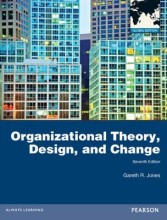Summary: Organizational Theory & Design
- This + 400k other summaries
- A unique study and practice tool
- Never study anything twice again
- Get the grades you hope for
- 100% sure, 100% understanding
Read the summary and the most important questions on Organizational Theory & design
-
1 Organization Theory
-
1.1 Chapter 1: ORGANIZATIONS AND ORGANIZATIONAL EFFECTIVENESS
This is a preview. There are 33 more flashcards available for chapter 1.1
Show more cards here -
How does an organization create value? Value creation takes place at three stages:
- Input
- Conversion
- Output
-
To increase specialization and the division of labour:
- People who work in organizations may become more productive and efficient at what they do than people who work alone.
- An organization allows individuals to focus on a narrow area of expertise, which allows them to become more skilled or specialized at what they do.
- The degree of specialization in a small company is lower
-
To manage the organizational environment
Managing complex environments is a task beyond the abilities of most individuals, but an organization has the resources to develop specialists to anticipate or attempt to influence the many pressures form the environment. -
To economize on transaction costs :
- Transaction costs: The costs associated with negotiating, monitoring and governing exchanges between people.
- Organization’s ability to control the exchanges between people reduces the transaction costs associated with these exchanges.
-
The importance of organizational design and change
Organizational design and change have important implications for a company’s ability to deal with contingencies, achieve a competitive advantage, manage diversity effectively and increase its efficiency and ability to innovate. -
PROMOTING EFFICIENCY, SPEED AND INNOVATION
- The way an organization’s structure links people in different specializations, such as research and marketing, determines how fast the organization can introduce new products.
- A culture based on entrepreneurial norms and values is more likely to encourage innovation than a culture that is conservative and bureaucratic because entrepreneurial values encourage people to learn how to respond and adapt to a changing situation.
-
Measuring effectiveness: Organizational goals
Official goals and operative goals are two types of goals that are used to evaluate organizational effectiveness. -
1.2 Chapter 3: ORGANIZING IN A CHANGING GLOBAL ENVIRONMENT
This is a preview. There are 28 more flashcards available for chapter 1.2
Show more cards here -
What is the organizational environment?
Environment: The set of forces surrounding an organization that have the potential to affect the way it operates and its access to scare resources. -
Sources of uncertainty in the organizational environment
The set of forces that cause these problems can be looked at in another way: in terms of how they cause uncertainty because they affect the complexity, dynamism and richness of the environment. As these forces cause the environment to become more complex, less stable and poorer, the level of uncertainty increases -
Inter-organizational strategies for managing resources dependencies
To reduce uncertainty, an organization needs to devise inter-organizational strategies to manage the resource interdependencies in its specific and general environment
- Higher grades + faster learning
- Never study anything twice
- 100% sure, 100% understanding
Topics related to Summary: Organizational Theory & Design
-
Organization Theory - ORGANIZINGIN A CHANGING GLOBAL ENVIRONMENT
-
Designing effective organizational structures - BASIC CHALLENGES OF ORGANIZATIONALDESIGN
-
Designing effective organizational structures - DESIGNINGORGANIZATIONAL STRUCTURE: AUTHORITYAND CONTROL
-
Designing effective organizational structures - DESIGNINGORGANIZATIONALSTURCTURE: SPECIALIZATION AND COORDINATION
-
Growing effective organizational cultures - CREATING AND MANAGING ORGANIZATIONAL CULTURE
-
Growing effective organizational cultures - STAKEHOLDERS, MANAGERS AND ETHICS
-
Developing successful organizational strategy and innovation - Organizational Design and Strategy in a Changing Global Environment - Introduction
-
Developing successful organizational strategy and innovation - Organizational Design, Competences, and Technology
-
Leveraging (information) technology for innovation and organizational learning
-
Organizational change and transformation - TYPESANDFORMSOFORGANIZATIONALCHANGE
-
Lectures + exam questions































